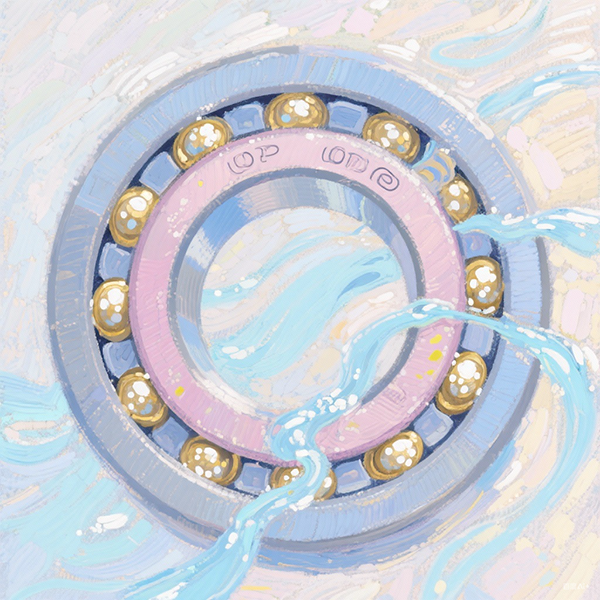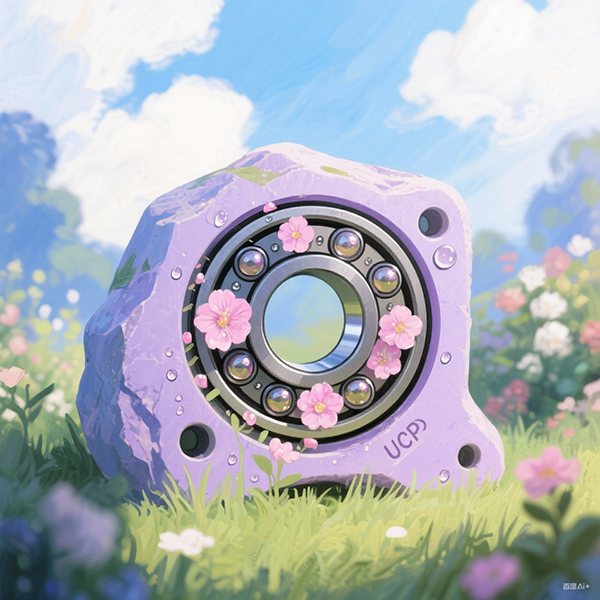UCP bearings, also known as sleeved spherical plain bearings, are extensively employed in diverse mechanical equipment owing to their self – aligning capabilities. Precise installation and meticulous maintenance are of paramount importance for ensuring the longevity of these bearings and the stable operation of the associated equipment. The following presents in – depth precautions regarding the installation and maintenance of UCP bearings:
I. Installation Precautions
1. Pre – installation Preparations
Environmental Requirements: The installation process should be conducted in a dry and contamination – free environment. This is to prevent dust and other contaminants from infiltrating the bearings, which could potentially compromise their performance and lifespan.
Surface Treatment: The shaft neck surface must be meticulously cleaned and polished to achieve a smooth finish. Any burrs or protrusions should be removed, and a layer of anti – rust lubricating oil should be applied. This not only protects the shaft from corrosion but also facilitates the installation process.
Dimension Verification: It is essential to confirm that the dimensions of the shaft and the bearing housing adhere strictly to the specifications outlined in the design drawings. Additionally, a thorough inspection of the mating surfaces should be carried out to identify any scratches or irregularities that could affect the fit.
Tool Preparation: Assemble all the necessary installation tools, such as sleeves and hook – type wrenches. Using inappropriate tools can lead to installation errors and potential damage to the bearings or related components.
2. Installation Steps
Preliminary Installation: Begin by removing the bearing cover fixing pin. Apply lubricating oil evenly on the mating surfaces of the bearing housing and the bearing. Subsequently, carefully install the bearing into the bearing housing.
Shaft Assembly: Mount the bearing housing onto the shaft as an integrated unit. Push it to the designated position, but refrain from tightening the fixing bolts at this stage.
Position Adjustment: After installing the bearing at the other end of the same shaft, rotate the shaft several times. This rotation allows the bearings to automatically adjust their positions. Once the alignment is optimized, tighten the bearing housing bolts.
Fixation Methods:
Positioning Screw Locking: Use a hex wrench or torque wrench to securely tighten the two positioning screws. This method provides a reliable means of fixing the bearing in place.
Eccentric Ring Locking: Employ a hook – type wrench to turn the eccentric locking ring in the main rotation direction. Subsequently, use a hex wrench to tighten the positioning screws, ensuring a stable connection.
Locking Sleeve Locking: Utilize a hook – type wrench to turn the locking sleeve lock nut. Press the device firmly into the locking sleeve to achieve a secure fit.
3. Installation Technical Considerations
Force Application: When installing the bearings, force must be applied precisely to the appropriate components. Specifically, the inner ring should be installed on the shaft, and the outer ring on the bearing housing. Avoid applying force to incorrect areas, as this can cause damage to the raceway surface.
Uniform Force Distribution: During the installation process, the applied force should be perpendicular and evenly distributed. This helps prevent uneven stress on the bearings, which could lead to premature wear or damage.
Heating Installation (for Large – sized Bearings with Interference Fit): For large – sized bearings with interference fits, oil bath heating (with a maximum temperature of 120°C) or electric induction heating methods can be utilized. These techniques facilitate the installation process by expanding the bearing slightly, allowing for a more seamless fit.
Contamination Prevention: Bearings should be opened only when they are ready to be installed. Throughout the installation process, maintain a clean working environment to minimize the risk of contamination.
II. Daily Maintenance Practices
1. Lubrication Management
Lubricant Selection: Select the appropriate lubricating grease based on the specific working environment of the bearings. For high – temperature applications, it is recommended to use lubricating grease with a drop point exceeding 180°C.
Lubrication Interval: Regularly replenish the lubricant to ensure optimal performance. In high – temperature environments, the replenishment cycle should be shortened to account for increased lubricant degradation.
Lubrication Quantity Control: Avoid over – lubricating the outer spherical bearings, as excessive lubrication can cause overheating. Conversely, insufficient lubrication can lead to accelerated wear. Maintain a proper balance to ensure the bearings’ longevity.
Lubricant Replacement: Before injecting new lubricant, thoroughly remove any old lubricant. It is advisable to filter the new lubricant before use to prevent the introduction of contaminants.
2. Operational Monitoring
Temperature Monitoring: Install temperature sensors at critical locations to continuously monitor the bearing temperature. If the temperature rises abnormally and persistently, conduct a prompt inspection to identify and address the underlying issue.
Vibration Detection: Employ a vibration analyzer to measure the vibration levels of the bearings. Abnormal vibration patterns may indicate installation problems, lubrication deficiencies, or other mechanical issues.
Noise Inspection: Use a stethoscope to monitor the running noise of the bearings. Unusual noises can be an indication of internal damage, such as metal – to – metal contact or cage wear, or insufficient lubrication.
Condition Assessment: Regularly inspect the appearance, lubrication condition, and fixation status of the bearings. This proactive approach allows for the early detection of potential problems, enabling timely maintenance and preventing more significant issues.
3. Cleaning and Preservation
Environmental Cleaning: Enhance the ventilation of the equipment and promptly remove oil stains, iron filings, and dust. This helps prevent foreign objects from entering the bearings and causing damage.
Regular Cleaning: For bearings in inventory, conduct a comprehensive cleaning once a year. After cleaning, package the bearings with appropriate anti – rust treatment to protect them during storage.
Sealing Protection: Utilize suitable seals and protective covers to minimize the ingress of dust and other particulate matter. This helps maintain a clean operating environment for the bearings.
Storage Conditions: Store bearings in a clean and dry warehouse with a relative humidity not exceeding 65%. Avoid storing bearings together with chemical products, as they may cause corrosion or other damage.
III. Common Faults and Preventive Strategies
1. Typical Fault Types
Fault Phenomenon Possible Causes Preventive Measures
Excessive Bearing Heating Insufficient lubrication, overload, poor cooling Ensure proper lubrication, control the load, and improve cooling conditions
Abnormal Noise Metal direct contact, cage damage Replenish lubrication in a timely manner and inspect the cage condition regularly
Wear and Peeling Lubrication fatigue pitting, entry of contaminants Maintain a clean working environment and replace the lubricant at regular intervals
Burnt and Discolored Appearance Abnormal working temperature, excessive friction Monitor the temperature closely and ensure adequate lubrication
Cage Damage Shock load, improper installation Install the bearings correctly, avoid overloading, and minimize exposure to impact forces
2. Key Fault Prevention Points
Lubrication Management: Approximately 80% of bearing faults are attributed to improper lubrication. Therefore, it is crucial to use the correct type and quantity of lubricants to ensure optimal performance.
Contamination Control: Thoroughly clean the working area, tools, and hands before handling bearings. This simple yet effective measure can significantly reduce the risk of contamination.
Correct Installation: Strictly adhere to the manufacturer’s installation instructions to ensure a proper fit. Avoid installations that are either too loose or too tight, as both can lead to premature wear and failure.
Alignment Check: Ensure that the shaft and the bearing housing are precisely aligned. Misalignment can cause uneven stress distribution and overheating, ultimately shortening the bearing’s lifespan.
Load Monitoring: Keep the bearing operating within its rated load range. Overloading can cause excessive stress on the bearings, leading to accelerated wear and potential failure.
3. Fault Handling Procedure
Initial Diagnosis: Determine the nature of the fault by analyzing abnormal temperature, vibration, and noise patterns. This initial assessment helps in identifying the root cause of the problem.
Disassembly Inspection: Follow the correct disassembly steps to access the bearing components. Thoroughly inspect each component for signs of wear, damage, or other irregularities.
Cleaning and Evaluation: Conduct a two – step cleaning process, consisting of a rough wash and a fine wash, to remove contaminants and debris. After cleaning, evaluate whether the bearing can be repaired or if replacement is necessary.
Replacement Decision: For bearings that are severely worn, deformed, or damaged beyond repair, replace them immediately to avoid further equipment damage.
Reinstallation: Reassemble the bearing according to the standard installation process, ensuring that all parameters are within the specified tolerances. This ensures the proper functioning of the bearing and the overall equipment.
By adhering to the above – mentioned installation specifications and maintenance guidelines, the service life of UCP bearings can be significantly extended. This not only reduces unplanned downtime but also ensures the stable operation of the equipment. Implementing a preventive maintenance plan is highly recommended, as it is more cost – effective than.

Post time: Aug-25-2025










